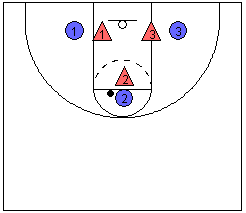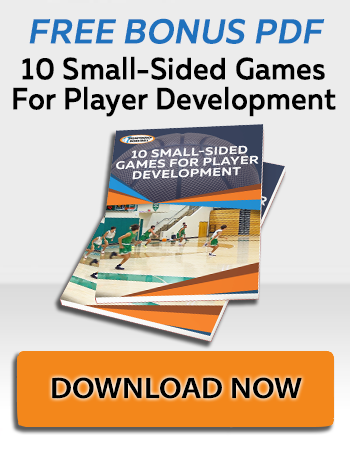3-on-3 No-Dribble Keep Away
This drill provides a fun way to teach kids to move without the ball to get open for a pass and provides a context for developing an understanding of effective spacing. For the passer, it provides practice in pivoting and protecting the ball from a defender. Obviously, it helps kids overcome dribble mania and to see the court.
Instructions

- The team on offense keeps the ball for two minutes, which is one round. Depending on the age range, you might consider finding a fun piece of music that lasts about two minutes to make the drill more engaging.
- The team with the ball gets one point every time they complete a pass to a teammate.
- There has to be a pass every five seconds. If the team does not pass within the five seconds, they lose a point and the counting starts over. They can get negative points, but this isn't likely (In fact, if this is happening, you should stop the drill and teach the prerequisite cutting skills more thoroughly). The coach will count each five second sequence out loud.
- A steal taking more than five seconds to pass, dribbling, or a pass that goes out of bounds erases a point, but the 'offense' gets the ball back for the remainder of the round.
- After one round, the offense and defense change roles and you play round two.
- Play for two or three complete cycles and provide the kids with positive rewards for their total completed passes. For instance, you could give kids some skittles or the like.
- Feel free to adjust the time parameters to suit the age and abilities of your kids.
- Teach kids simple pivoting principles before turning them loose in this drill.
- Teach kids how to v-cut and backdoor cut.
- As the skill level of the kids advance, introduce screens away from the ball to free cutters.
- Provide defenders with the basics of defending the passing lanes effectively. This is a foundational drill for denial defensive techniques.
You can find over 60 youth drills in Jim Huber's The Youth Coaching System.
To get FREE 10 Small-Sided Games For Player Development, click the banner below
|
||||||||||||||||||||||||




 Facebook (145k Followers)
Facebook (145k Followers) YouTube (152k Subscribers)
YouTube (152k Subscribers) Twitter (33k Followers)
Twitter (33k Followers) Q&A Forum
Q&A Forum Podcasts
Podcasts